Literaces and Communication for Healthcare Assignment 2022
VerifiedAdded on 2022/10/11
|8
|2029
|11
Assignment
AI Summary
Contribute Materials
Your contribution can guide someone’s learning journey. Share your
documents today.
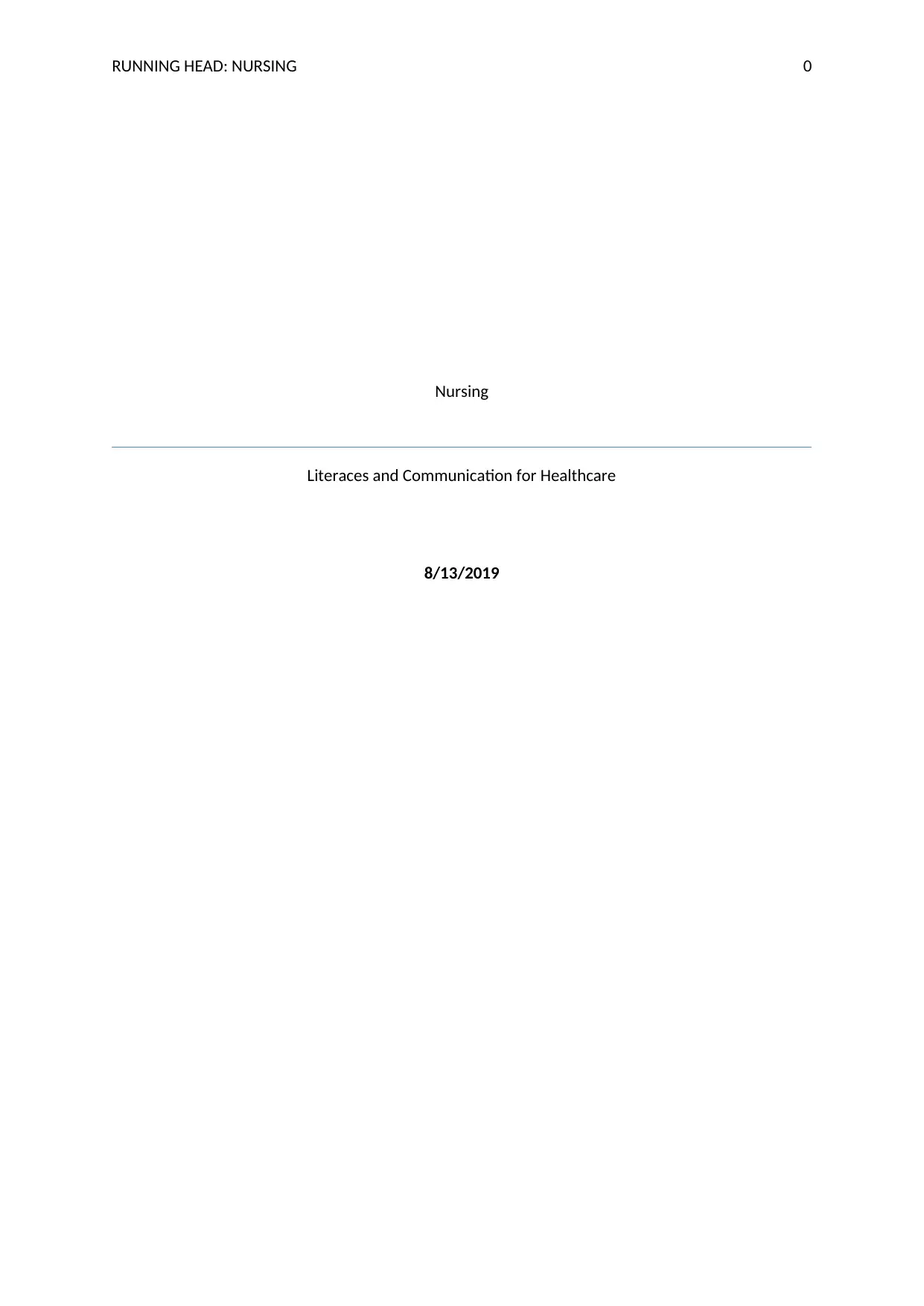
RUNNING HEAD: NURSING 0
Nursing
Literaces and Communication for Healthcare
8/13/2019
Nursing
Literaces and Communication for Healthcare
8/13/2019
Secure Best Marks with AI Grader
Need help grading? Try our AI Grader for instant feedback on your assignments.
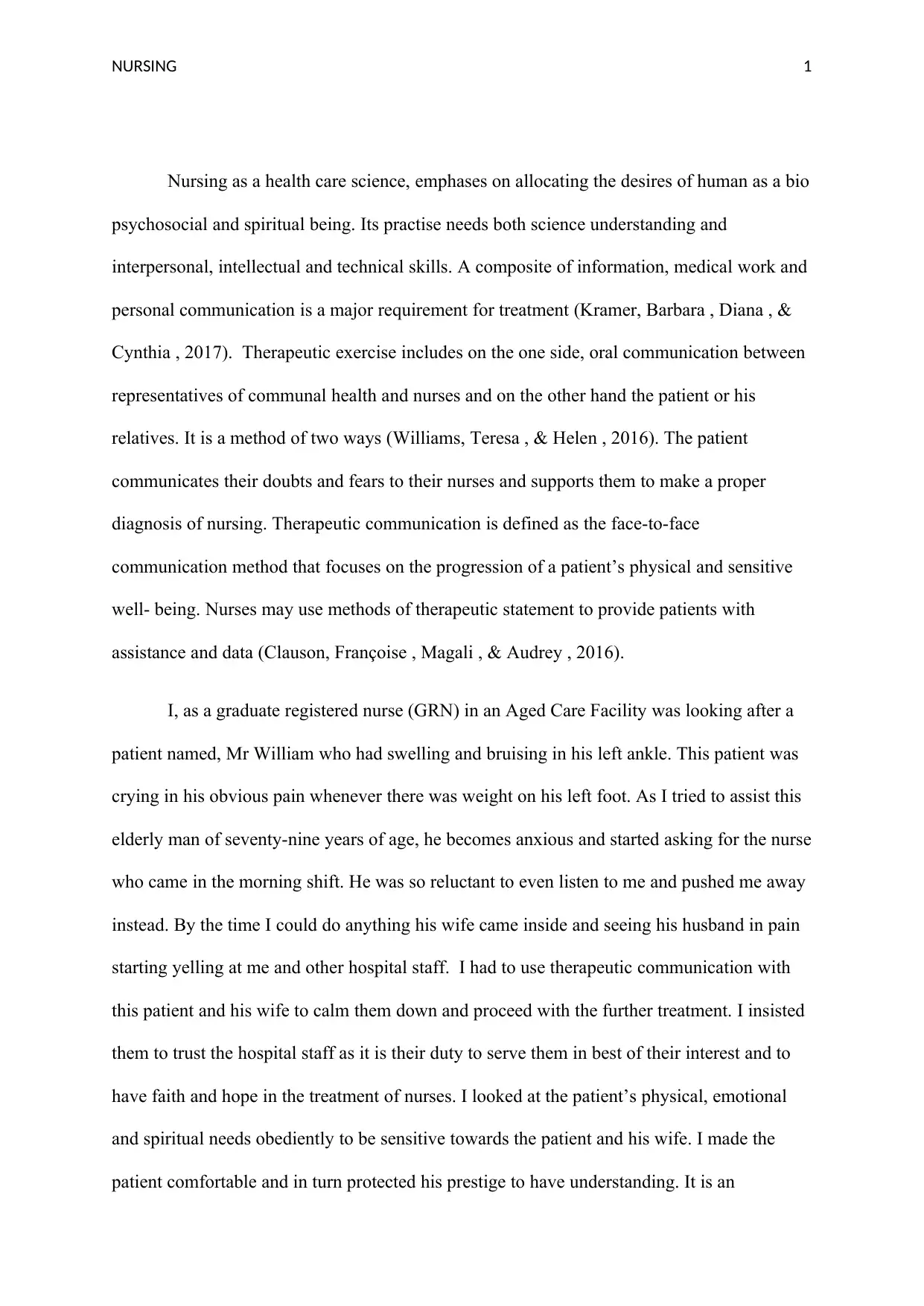
NURSING 1
Nursing as a health care science, emphases on allocating the desires of human as a bio
psychosocial and spiritual being. Its practise needs both science understanding and
interpersonal, intellectual and technical skills. A composite of information, medical work and
personal communication is a major requirement for treatment (Kramer, Barbara , Diana , &
Cynthia , 2017). Therapeutic exercise includes on the one side, oral communication between
representatives of communal health and nurses and on the other hand the patient or his
relatives. It is a method of two ways (Williams, Teresa , & Helen , 2016). The patient
communicates their doubts and fears to their nurses and supports them to make a proper
diagnosis of nursing. Therapeutic communication is defined as the face-to-face
communication method that focuses on the progression of a patient’s physical and sensitive
well- being. Nurses may use methods of therapeutic statement to provide patients with
assistance and data (Clauson, Françoise , Magali , & Audrey , 2016).
I, as a graduate registered nurse (GRN) in an Aged Care Facility was looking after a
patient named, Mr William who had swelling and bruising in his left ankle. This patient was
crying in his obvious pain whenever there was weight on his left foot. As I tried to assist this
elderly man of seventy-nine years of age, he becomes anxious and started asking for the nurse
who came in the morning shift. He was so reluctant to even listen to me and pushed me away
instead. By the time I could do anything his wife came inside and seeing his husband in pain
starting yelling at me and other hospital staff. I had to use therapeutic communication with
this patient and his wife to calm them down and proceed with the further treatment. I insisted
them to trust the hospital staff as it is their duty to serve them in best of their interest and to
have faith and hope in the treatment of nurses. I looked at the patient’s physical, emotional
and spiritual needs obediently to be sensitive towards the patient and his wife. I made the
patient comfortable and in turn protected his prestige to have understanding. It is an
Nursing as a health care science, emphases on allocating the desires of human as a bio
psychosocial and spiritual being. Its practise needs both science understanding and
interpersonal, intellectual and technical skills. A composite of information, medical work and
personal communication is a major requirement for treatment (Kramer, Barbara , Diana , &
Cynthia , 2017). Therapeutic exercise includes on the one side, oral communication between
representatives of communal health and nurses and on the other hand the patient or his
relatives. It is a method of two ways (Williams, Teresa , & Helen , 2016). The patient
communicates their doubts and fears to their nurses and supports them to make a proper
diagnosis of nursing. Therapeutic communication is defined as the face-to-face
communication method that focuses on the progression of a patient’s physical and sensitive
well- being. Nurses may use methods of therapeutic statement to provide patients with
assistance and data (Clauson, Françoise , Magali , & Audrey , 2016).
I, as a graduate registered nurse (GRN) in an Aged Care Facility was looking after a
patient named, Mr William who had swelling and bruising in his left ankle. This patient was
crying in his obvious pain whenever there was weight on his left foot. As I tried to assist this
elderly man of seventy-nine years of age, he becomes anxious and started asking for the nurse
who came in the morning shift. He was so reluctant to even listen to me and pushed me away
instead. By the time I could do anything his wife came inside and seeing his husband in pain
starting yelling at me and other hospital staff. I had to use therapeutic communication with
this patient and his wife to calm them down and proceed with the further treatment. I insisted
them to trust the hospital staff as it is their duty to serve them in best of their interest and to
have faith and hope in the treatment of nurses. I looked at the patient’s physical, emotional
and spiritual needs obediently to be sensitive towards the patient and his wife. I made the
patient comfortable and in turn protected his prestige to have understanding. It is an
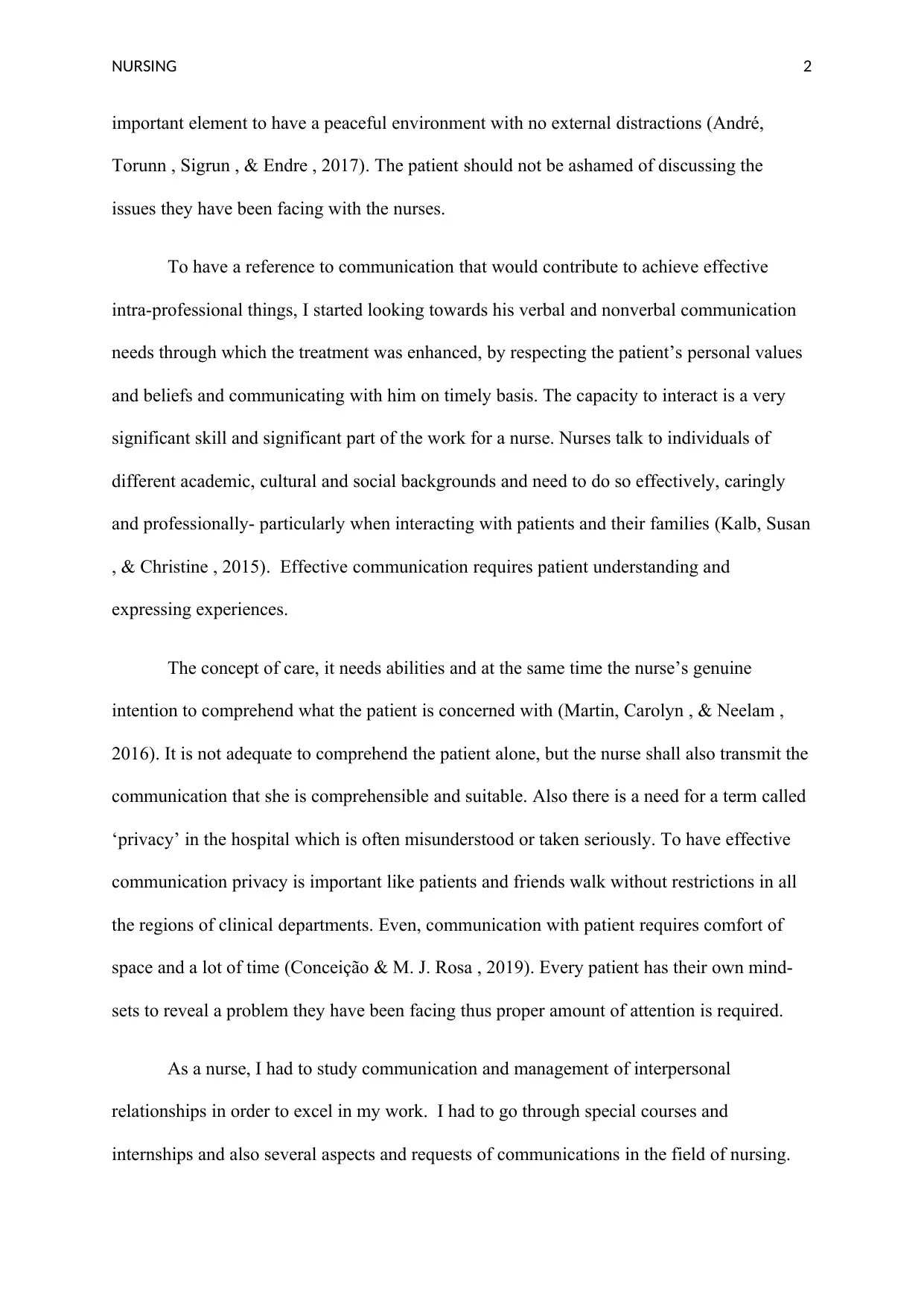
NURSING 2
important element to have a peaceful environment with no external distractions (André,
Torunn , Sigrun , & Endre , 2017). The patient should not be ashamed of discussing the
issues they have been facing with the nurses.
To have a reference to communication that would contribute to achieve effective
intra-professional things, I started looking towards his verbal and nonverbal communication
needs through which the treatment was enhanced, by respecting the patient’s personal values
and beliefs and communicating with him on timely basis. The capacity to interact is a very
significant skill and significant part of the work for a nurse. Nurses talk to individuals of
different academic, cultural and social backgrounds and need to do so effectively, caringly
and professionally- particularly when interacting with patients and their families (Kalb, Susan
, & Christine , 2015). Effective communication requires patient understanding and
expressing experiences.
The concept of care, it needs abilities and at the same time the nurse’s genuine
intention to comprehend what the patient is concerned with (Martin, Carolyn , & Neelam ,
2016). It is not adequate to comprehend the patient alone, but the nurse shall also transmit the
communication that she is comprehensible and suitable. Also there is a need for a term called
‘privacy’ in the hospital which is often misunderstood or taken seriously. To have effective
communication privacy is important like patients and friends walk without restrictions in all
the regions of clinical departments. Even, communication with patient requires comfort of
space and a lot of time (Conceição & M. J. Rosa , 2019). Every patient has their own mind-
sets to reveal a problem they have been facing thus proper amount of attention is required.
As a nurse, I had to study communication and management of interpersonal
relationships in order to excel in my work. I had to go through special courses and
internships and also several aspects and requests of communications in the field of nursing.
important element to have a peaceful environment with no external distractions (André,
Torunn , Sigrun , & Endre , 2017). The patient should not be ashamed of discussing the
issues they have been facing with the nurses.
To have a reference to communication that would contribute to achieve effective
intra-professional things, I started looking towards his verbal and nonverbal communication
needs through which the treatment was enhanced, by respecting the patient’s personal values
and beliefs and communicating with him on timely basis. The capacity to interact is a very
significant skill and significant part of the work for a nurse. Nurses talk to individuals of
different academic, cultural and social backgrounds and need to do so effectively, caringly
and professionally- particularly when interacting with patients and their families (Kalb, Susan
, & Christine , 2015). Effective communication requires patient understanding and
expressing experiences.
The concept of care, it needs abilities and at the same time the nurse’s genuine
intention to comprehend what the patient is concerned with (Martin, Carolyn , & Neelam ,
2016). It is not adequate to comprehend the patient alone, but the nurse shall also transmit the
communication that she is comprehensible and suitable. Also there is a need for a term called
‘privacy’ in the hospital which is often misunderstood or taken seriously. To have effective
communication privacy is important like patients and friends walk without restrictions in all
the regions of clinical departments. Even, communication with patient requires comfort of
space and a lot of time (Conceição & M. J. Rosa , 2019). Every patient has their own mind-
sets to reveal a problem they have been facing thus proper amount of attention is required.
As a nurse, I had to study communication and management of interpersonal
relationships in order to excel in my work. I had to go through special courses and
internships and also several aspects and requests of communications in the field of nursing.
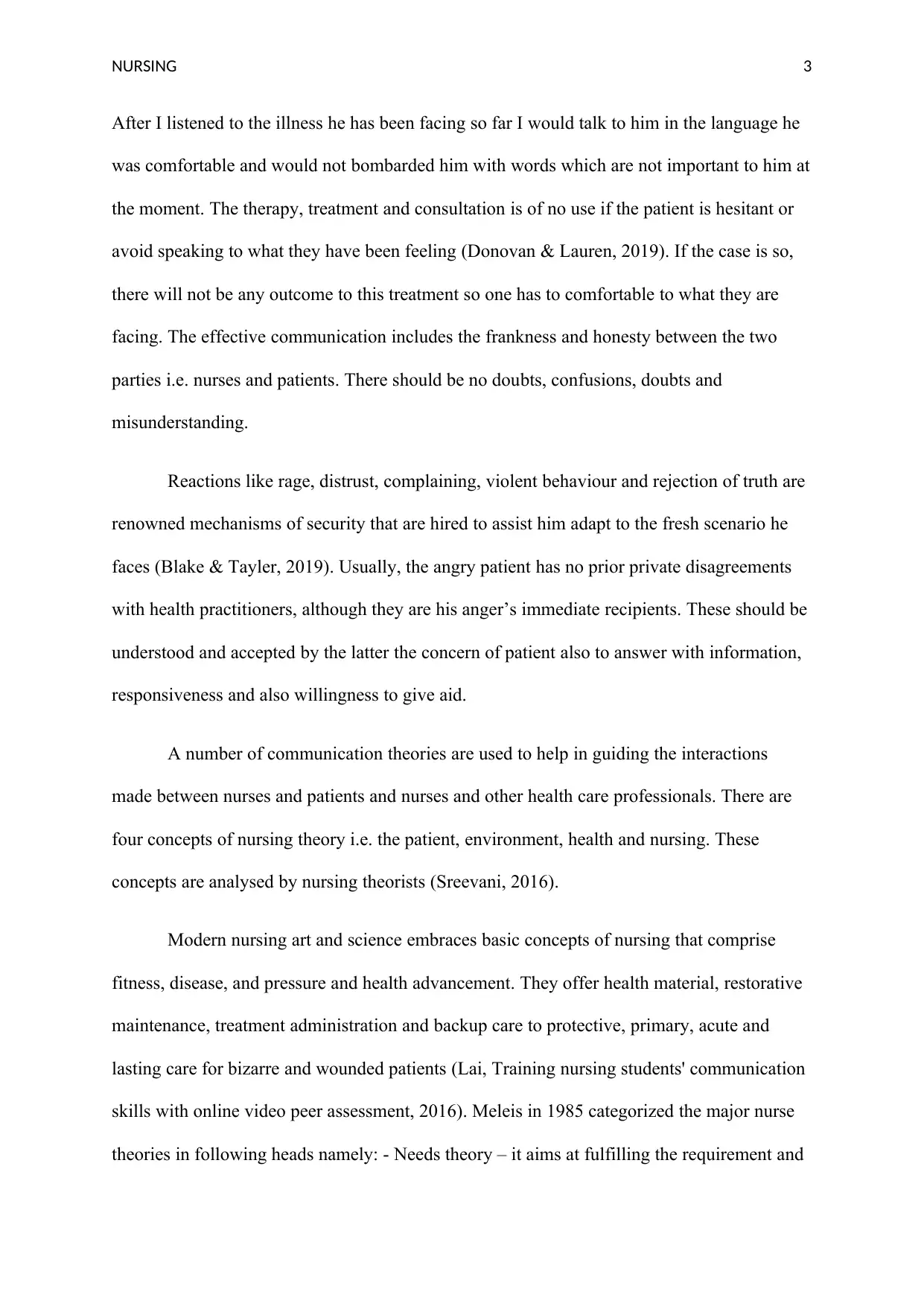
NURSING 3
After I listened to the illness he has been facing so far I would talk to him in the language he
was comfortable and would not bombarded him with words which are not important to him at
the moment. The therapy, treatment and consultation is of no use if the patient is hesitant or
avoid speaking to what they have been feeling (Donovan & Lauren, 2019). If the case is so,
there will not be any outcome to this treatment so one has to comfortable to what they are
facing. The effective communication includes the frankness and honesty between the two
parties i.e. nurses and patients. There should be no doubts, confusions, doubts and
misunderstanding.
Reactions like rage, distrust, complaining, violent behaviour and rejection of truth are
renowned mechanisms of security that are hired to assist him adapt to the fresh scenario he
faces (Blake & Tayler, 2019). Usually, the angry patient has no prior private disagreements
with health practitioners, although they are his anger’s immediate recipients. These should be
understood and accepted by the latter the concern of patient also to answer with information,
responsiveness and also willingness to give aid.
A number of communication theories are used to help in guiding the interactions
made between nurses and patients and nurses and other health care professionals. There are
four concepts of nursing theory i.e. the patient, environment, health and nursing. These
concepts are analysed by nursing theorists (Sreevani, 2016).
Modern nursing art and science embraces basic concepts of nursing that comprise
fitness, disease, and pressure and health advancement. They offer health material, restorative
maintenance, treatment administration and backup care to protective, primary, acute and
lasting care for bizarre and wounded patients (Lai, Training nursing students' communication
skills with online video peer assessment, 2016). Meleis in 1985 categorized the major nurse
theories in following heads namely: - Needs theory – it aims at fulfilling the requirement and
After I listened to the illness he has been facing so far I would talk to him in the language he
was comfortable and would not bombarded him with words which are not important to him at
the moment. The therapy, treatment and consultation is of no use if the patient is hesitant or
avoid speaking to what they have been feeling (Donovan & Lauren, 2019). If the case is so,
there will not be any outcome to this treatment so one has to comfortable to what they are
facing. The effective communication includes the frankness and honesty between the two
parties i.e. nurses and patients. There should be no doubts, confusions, doubts and
misunderstanding.
Reactions like rage, distrust, complaining, violent behaviour and rejection of truth are
renowned mechanisms of security that are hired to assist him adapt to the fresh scenario he
faces (Blake & Tayler, 2019). Usually, the angry patient has no prior private disagreements
with health practitioners, although they are his anger’s immediate recipients. These should be
understood and accepted by the latter the concern of patient also to answer with information,
responsiveness and also willingness to give aid.
A number of communication theories are used to help in guiding the interactions
made between nurses and patients and nurses and other health care professionals. There are
four concepts of nursing theory i.e. the patient, environment, health and nursing. These
concepts are analysed by nursing theorists (Sreevani, 2016).
Modern nursing art and science embraces basic concepts of nursing that comprise
fitness, disease, and pressure and health advancement. They offer health material, restorative
maintenance, treatment administration and backup care to protective, primary, acute and
lasting care for bizarre and wounded patients (Lai, Training nursing students' communication
skills with online video peer assessment, 2016). Meleis in 1985 categorized the major nurse
theories in following heads namely: - Needs theory – it aims at fulfilling the requirement and
Secure Best Marks with AI Grader
Need help grading? Try our AI Grader for instant feedback on your assignments.
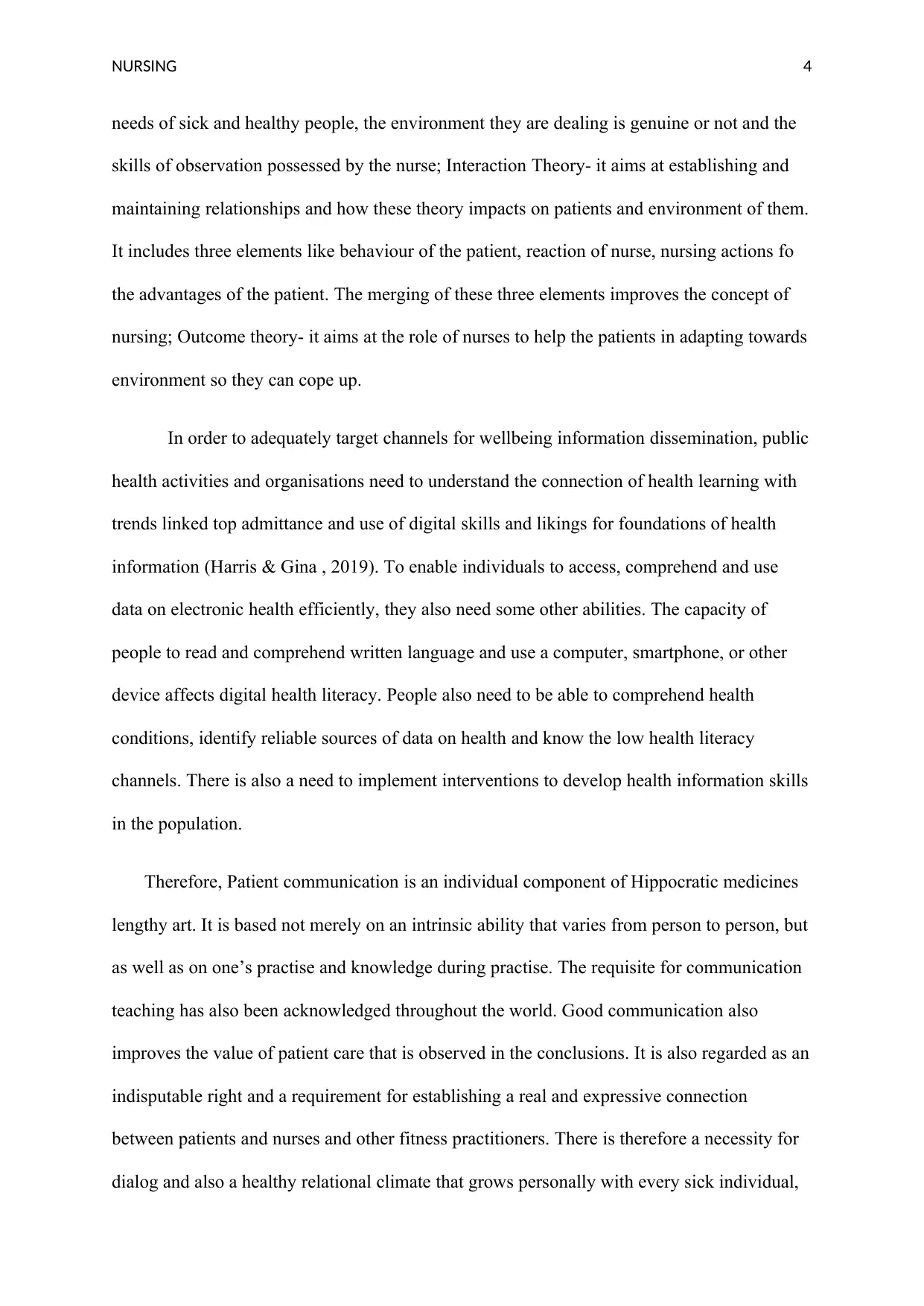
NURSING 4
needs of sick and healthy people, the environment they are dealing is genuine or not and the
skills of observation possessed by the nurse; Interaction Theory- it aims at establishing and
maintaining relationships and how these theory impacts on patients and environment of them.
It includes three elements like behaviour of the patient, reaction of nurse, nursing actions fo
the advantages of the patient. The merging of these three elements improves the concept of
nursing; Outcome theory- it aims at the role of nurses to help the patients in adapting towards
environment so they can cope up.
In order to adequately target channels for wellbeing information dissemination, public
health activities and organisations need to understand the connection of health learning with
trends linked top admittance and use of digital skills and likings for foundations of health
information (Harris & Gina , 2019). To enable individuals to access, comprehend and use
data on electronic health efficiently, they also need some other abilities. The capacity of
people to read and comprehend written language and use a computer, smartphone, or other
device affects digital health literacy. People also need to be able to comprehend health
conditions, identify reliable sources of data on health and know the low health literacy
channels. There is also a need to implement interventions to develop health information skills
in the population.
Therefore, Patient communication is an individual component of Hippocratic medicines
lengthy art. It is based not merely on an intrinsic ability that varies from person to person, but
as well as on one’s practise and knowledge during practise. The requisite for communication
teaching has also been acknowledged throughout the world. Good communication also
improves the value of patient care that is observed in the conclusions. It is also regarded as an
indisputable right and a requirement for establishing a real and expressive connection
between patients and nurses and other fitness practitioners. There is therefore a necessity for
dialog and also a healthy relational climate that grows personally with every sick individual,
needs of sick and healthy people, the environment they are dealing is genuine or not and the
skills of observation possessed by the nurse; Interaction Theory- it aims at establishing and
maintaining relationships and how these theory impacts on patients and environment of them.
It includes three elements like behaviour of the patient, reaction of nurse, nursing actions fo
the advantages of the patient. The merging of these three elements improves the concept of
nursing; Outcome theory- it aims at the role of nurses to help the patients in adapting towards
environment so they can cope up.
In order to adequately target channels for wellbeing information dissemination, public
health activities and organisations need to understand the connection of health learning with
trends linked top admittance and use of digital skills and likings for foundations of health
information (Harris & Gina , 2019). To enable individuals to access, comprehend and use
data on electronic health efficiently, they also need some other abilities. The capacity of
people to read and comprehend written language and use a computer, smartphone, or other
device affects digital health literacy. People also need to be able to comprehend health
conditions, identify reliable sources of data on health and know the low health literacy
channels. There is also a need to implement interventions to develop health information skills
in the population.
Therefore, Patient communication is an individual component of Hippocratic medicines
lengthy art. It is based not merely on an intrinsic ability that varies from person to person, but
as well as on one’s practise and knowledge during practise. The requisite for communication
teaching has also been acknowledged throughout the world. Good communication also
improves the value of patient care that is observed in the conclusions. It is also regarded as an
indisputable right and a requirement for establishing a real and expressive connection
between patients and nurses and other fitness practitioners. There is therefore a necessity for
dialog and also a healthy relational climate that grows personally with every sick individual,
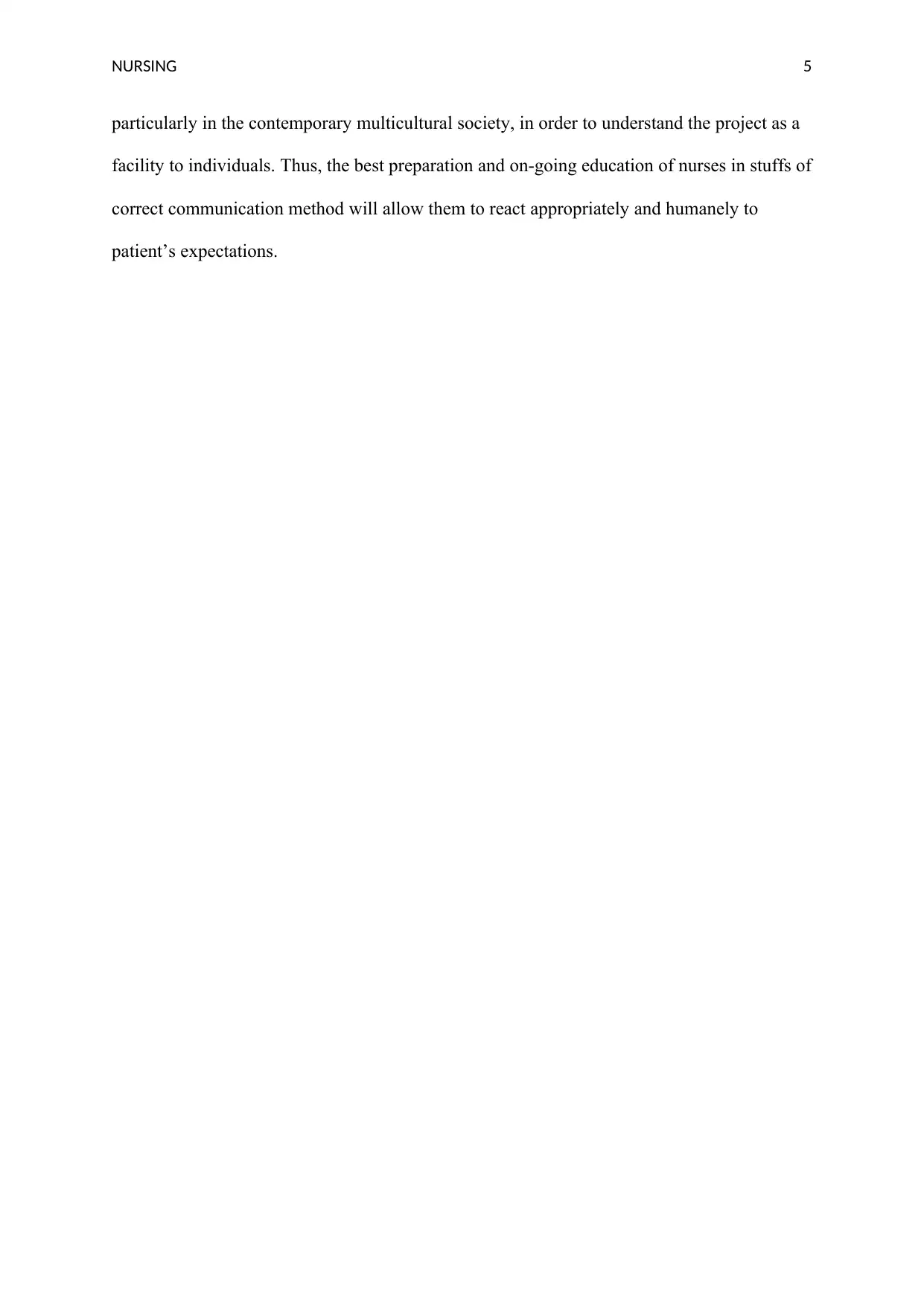
NURSING 5
particularly in the contemporary multicultural society, in order to understand the project as a
facility to individuals. Thus, the best preparation and on-going education of nurses in stuffs of
correct communication method will allow them to react appropriately and humanely to
patient’s expectations.
particularly in the contemporary multicultural society, in order to understand the project as a
facility to individuals. Thus, the best preparation and on-going education of nurses in stuffs of
correct communication method will allow them to react appropriately and humanely to
patient’s expectations.
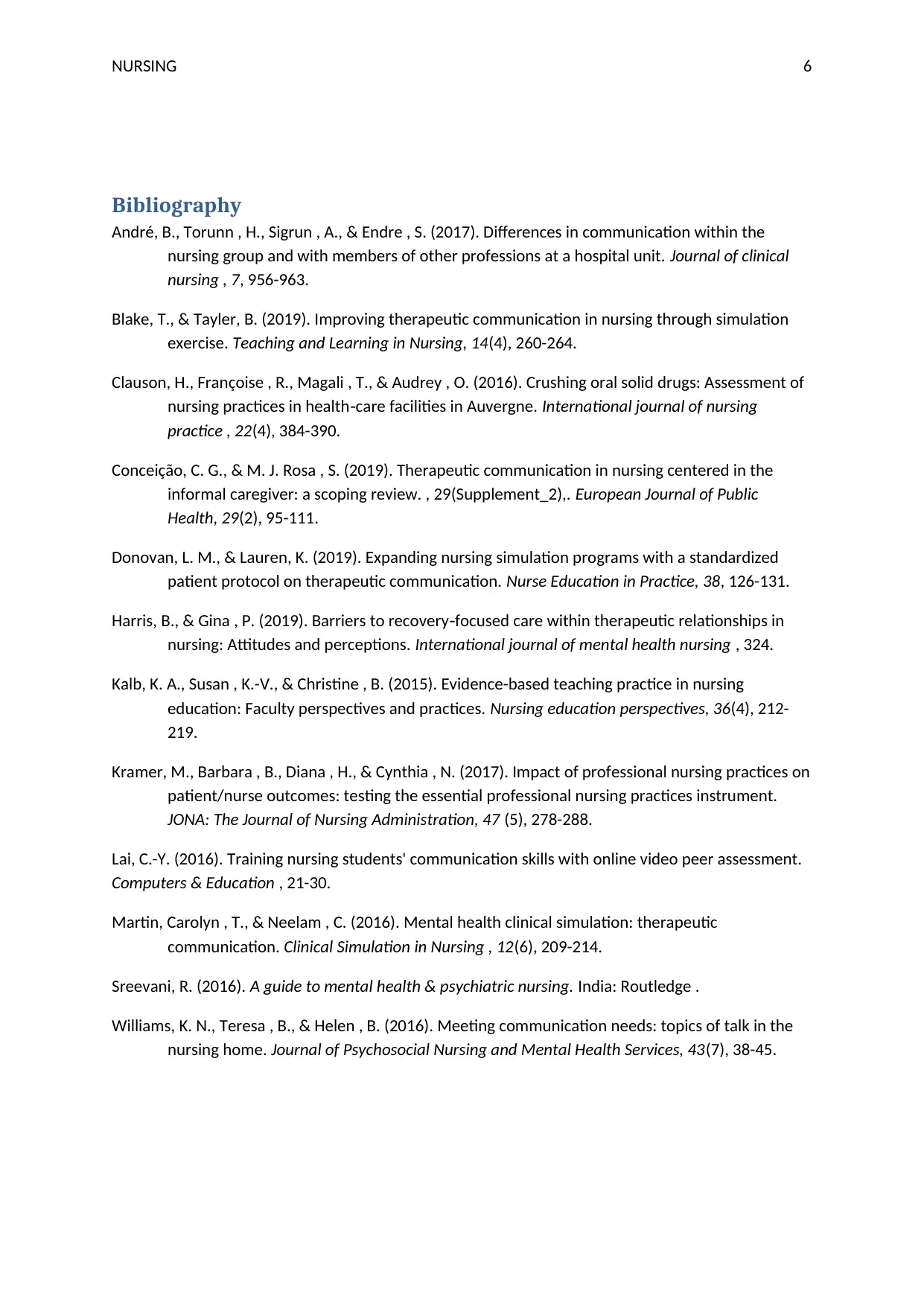
NURSING 6
Bibliography
André, B., Torunn , H., Sigrun , A., & Endre , S. (2017). Differences in communication within the
nursing group and with members of other professions at a hospital unit. Journal of clinical
nursing , 7, 956-963.
Blake, T., & Tayler, B. (2019). Improving therapeutic communication in nursing through simulation
exercise. Teaching and Learning in Nursing, 14(4), 260-264.
Clauson, H., Françoise , R., Magali , T., & Audrey , O. (2016). Crushing oral solid drugs: Assessment of
nursing practices in health care facilities in Auvergne.‐ International journal of nursing
practice , 22(4), 384-390.
Conceição, C. G., & M. J. Rosa , S. (2019). Therapeutic communication in nursing centered in the
informal caregiver: a scoping review. , 29(Supplement_2),. European Journal of Public
Health, 29(2), 95-111.
Donovan, L. M., & Lauren, K. (2019). Expanding nursing simulation programs with a standardized
patient protocol on therapeutic communication. Nurse Education in Practice, 38, 126-131.
Harris, B., & Gina , P. (2019). Barriers to recovery focused care within therapeutic relationships in‐
nursing: Attitudes and perceptions. International journal of mental health nursing , 324.
Kalb, K. A., Susan , K.-V., & Christine , B. (2015). Evidence-based teaching practice in nursing
education: Faculty perspectives and practices. Nursing education perspectives, 36(4), 212-
219.
Kramer, M., Barbara , B., Diana , H., & Cynthia , N. (2017). Impact of professional nursing practices on
patient/nurse outcomes: testing the essential professional nursing practices instrument.
JONA: The Journal of Nursing Administration, 47 (5), 278-288.
Lai, C.-Y. (2016). Training nursing students' communication skills with online video peer assessment.
Computers & Education , 21-30.
Martin, Carolyn , T., & Neelam , C. (2016). Mental health clinical simulation: therapeutic
communication. Clinical Simulation in Nursing , 12(6), 209-214.
Sreevani, R. (2016). A guide to mental health & psychiatric nursing. India: Routledge .
Williams, K. N., Teresa , B., & Helen , B. (2016). Meeting communication needs: topics of talk in the
nursing home. Journal of Psychosocial Nursing and Mental Health Services, 43(7), 38-45.
Bibliography
André, B., Torunn , H., Sigrun , A., & Endre , S. (2017). Differences in communication within the
nursing group and with members of other professions at a hospital unit. Journal of clinical
nursing , 7, 956-963.
Blake, T., & Tayler, B. (2019). Improving therapeutic communication in nursing through simulation
exercise. Teaching and Learning in Nursing, 14(4), 260-264.
Clauson, H., Françoise , R., Magali , T., & Audrey , O. (2016). Crushing oral solid drugs: Assessment of
nursing practices in health care facilities in Auvergne.‐ International journal of nursing
practice , 22(4), 384-390.
Conceição, C. G., & M. J. Rosa , S. (2019). Therapeutic communication in nursing centered in the
informal caregiver: a scoping review. , 29(Supplement_2),. European Journal of Public
Health, 29(2), 95-111.
Donovan, L. M., & Lauren, K. (2019). Expanding nursing simulation programs with a standardized
patient protocol on therapeutic communication. Nurse Education in Practice, 38, 126-131.
Harris, B., & Gina , P. (2019). Barriers to recovery focused care within therapeutic relationships in‐
nursing: Attitudes and perceptions. International journal of mental health nursing , 324.
Kalb, K. A., Susan , K.-V., & Christine , B. (2015). Evidence-based teaching practice in nursing
education: Faculty perspectives and practices. Nursing education perspectives, 36(4), 212-
219.
Kramer, M., Barbara , B., Diana , H., & Cynthia , N. (2017). Impact of professional nursing practices on
patient/nurse outcomes: testing the essential professional nursing practices instrument.
JONA: The Journal of Nursing Administration, 47 (5), 278-288.
Lai, C.-Y. (2016). Training nursing students' communication skills with online video peer assessment.
Computers & Education , 21-30.
Martin, Carolyn , T., & Neelam , C. (2016). Mental health clinical simulation: therapeutic
communication. Clinical Simulation in Nursing , 12(6), 209-214.
Sreevani, R. (2016). A guide to mental health & psychiatric nursing. India: Routledge .
Williams, K. N., Teresa , B., & Helen , B. (2016). Meeting communication needs: topics of talk in the
nursing home. Journal of Psychosocial Nursing and Mental Health Services, 43(7), 38-45.
Paraphrase This Document
Need a fresh take? Get an instant paraphrase of this document with our AI Paraphraser

NURSING 7
1 out of 8
Related Documents
Your All-in-One AI-Powered Toolkit for Academic Success.
+13062052269
info@desklib.com
Available 24*7 on WhatsApp / Email
![[object Object]](/_next/static/media/star-bottom.7253800d.svg)
Unlock your academic potential
© 2024 | Zucol Services PVT LTD | All rights reserved.





